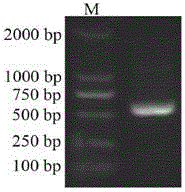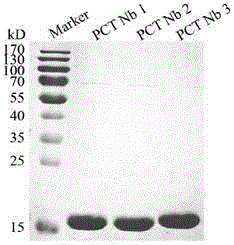Natural nanometer antibody library for Bactrian camel phage display as well as construction method and usage thereof
A phage display and nanobody technology, applied in the field of biomedicine or biopharmaceuticals, to achieve the effects of good quality, long time to solve, and rich diversity
- Summary
- Abstract
- Description
- Claims
- Application Information
AI Technical Summary
Problems solved by technology
Method used
Image
Examples
Embodiment 1
[0023] Example 1: Construction of a natural Bactrian camel-derived phage display nanobody library:
[0024] (1) Take 100 mL of blood samples from 20 Bactrian camels that have not been immunized with any antigen, and at the same time, kill another Bactrian camel that has not been immunized with any antigen, and remove its spleen. Lymphocytes were isolated from blood samples while the spleen was ground. Total mRNA was then extracted from lymphocytes and ground spleen. (2) Synthesize cDNA and use nested PCR to amplify VHH, the result is as follows figure 2 show. (3) 96 μg of pMECS phage display vector (supplied by Biovector) and 32 μg of VHH were digested with restriction endonucleases Pst I and Not I, and the two fragments were ligated. (5) The ligation product was electrotransformed into competent cell TG1 (Beijing Shenzhou Hongye Technology Co., Ltd.), and a natural Bactrian camel-derived phage display nanobody library was constructed and the storage capacity was determine...
Embodiment 2
[0046] Example 2: Screening process for Nanobodies against procalcitonin PCT or neutrophil gelatinase-associated lipocalin NGAL:
[0047] (1) Add 200 μL of transformed TG1 cells into 100 mL of 2×TY medium, and culture at 37° C. for 3 h. (2) Add 40 μL VCSM13 helper phage and let stand at room temperature for 30 minutes. (3) Centrifuge for 10 minutes, resuspend the cells precipitated by centrifugation into 250mL 2×TY medium, and culture overnight at 37°C; (4) Centrifuge the culture solution at 8000rpm for 30 minutes, take the supernatant, and use PEG / NaCl precipitation for amplification The precipitated phages were dissolved in PBS solution. (5) Dissolve in 100mM pH 8.2NaHCO 3 10 μg PCT and 10 μg NGAL were coupled to NUNC microtiter plates, placed overnight at 4°C, and a negative control was set up at the same time. (26) On the next day, 100 μL of 0.1% casein was added to each well, and blocked at room temperature for 2 hours. (7) After 2 hours, add 100 μL of collected phage...
Embodiment 3
[0048] Embodiment 3: use the enzyme-linked immunosorbent method (ELISA) of phage to screen specificity single positive clone:
[0049] (1) From the cell culture dish containing phage after the above four rounds of screening, pick 96 single colonies and inoculate them in TB medium containing 100ug / mL ampicillin (1L TB medium contains 2.3g potassium dihydrogen phosphate, 12.52 g dipotassium hydrogen phosphate, 12 g peptone, 24 g yeast extract, 4 mL glycerol), grow to the logarithmic phase, add IPTG with a final concentration of 1 mM, and culture overnight at 28°C. (2) Obtain the crude antibody by infiltration method, transfer the antibody to the ELISA plate coated with the corresponding antigen, and place it at room temperature for 1 hour. (3) Unbound antibodies were washed away with PBST, and a primary mouse anti-HA tag antibody (mouse anti-HA antibody, purchased from Beijing Kangwei Century Biotechnology Co., Ltd.) was added, and left at room temperature for 1 hour. (4) Unbou...
PUM
 Login to View More
Login to View More Abstract
Description
Claims
Application Information
 Login to View More
Login to View More - R&D
- Intellectual Property
- Life Sciences
- Materials
- Tech Scout
- Unparalleled Data Quality
- Higher Quality Content
- 60% Fewer Hallucinations
Browse by: Latest US Patents, China's latest patents, Technical Efficacy Thesaurus, Application Domain, Technology Topic, Popular Technical Reports.
© 2025 PatSnap. All rights reserved.Legal|Privacy policy|Modern Slavery Act Transparency Statement|Sitemap|About US| Contact US: help@patsnap.com



